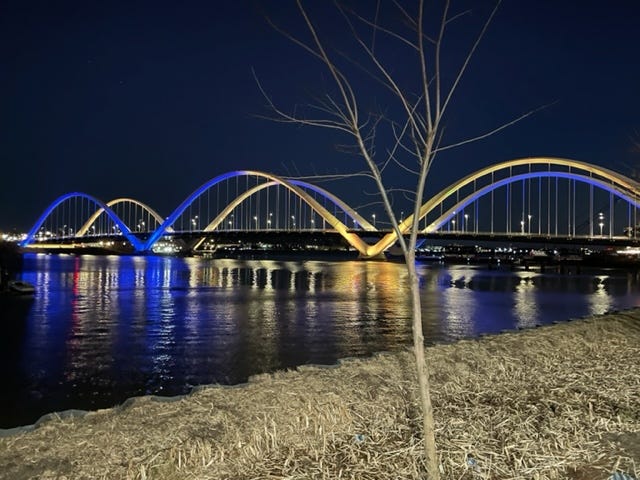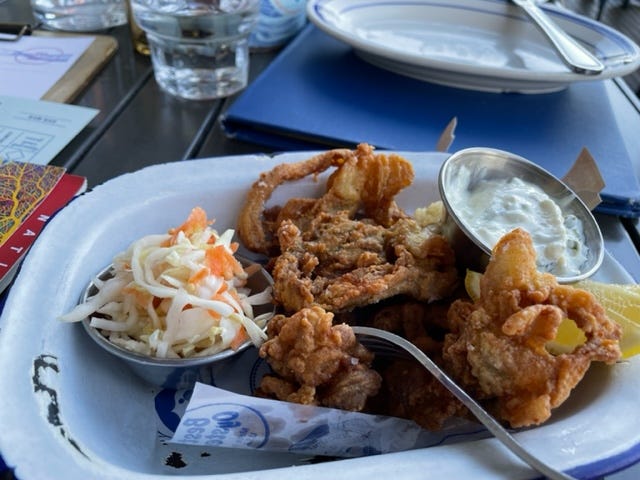I took a walk today, down towards one of the surprisingly uncelebrated rivers that runs through Washington, D.C., the Anacostia. The city has been working for a while now on a series of paths lining each side of the river, linking up everything from the National Arboretum (which has an eagle cam available — check out this NPR story for more information, but basically, the eagles are in some kind of telenovela situation in which long-time couple Mr. President and the First Lady split up last year and Mr. President has now taken a new mate, it’s all very exciting) to the Nationals Stadium and beyond.
My plan was to walk over the 11th Street Bridge, along the east side of the Anacostia River Trail, and then back across the Fredrick Douglass Bridge by the Nationals Stadium.
They’re still working on the bridge, but it’ll be gorgeous when it’s done.
The Fredrick Douglass Bridge lit up in support of Ukraine.
It’s a circuit that my friend Diana makes often, though I’m guessing she’s less likely to stop for a mid-walk pee and then maybe an old fashioned and some fried clam bellies and end up taking a Lyft home.
Well, it takes all kinds, I guess.
It was a gorgeous day — I saw my first red-winged blackbird of the year — but perhaps my favorite sighting was of this vulture keeping time with some motorcycles.
It reminded me, somehow, of all the explorations of darkness in the natural world I’ve been reading about or viewing lately. Not necessarily darkness in a sad or negative vein but more an examination of the earth, fungus, the generative properties of carrion and dirt.
I’ve started reading Underland by Robert McFarlane, and I can tell already that it’s going to blow me away. He writes at the very start:
Our common verb, “to understand” itself bears an old sense of passing beneath something in order fully to comprehend it. “To discover” is “to reveal by excavation,” “to descend and bring to the light,” “to fetch up from depth.” These are ancient associations.
I subscribe to Thomas Pluck’s Patreon, and his most recent story, There are Things in the Woods digs into this territory. The protagonist goes looking for a lost drone and hikes into increasingly isolated, increasingly dark, increasingly silent forest in his search. The creepiness of Pluck’s vegetation descriptions alone gets to me:
Thin white hairs peeked out of the moss like tiny fingers wriggling through.
In the dim light, they looked like peach fuzz on a child’s arm, almost a glow. Not sure if they were iridescent and affected by the tiniest rays of light from above, but I thought I could see waves over them, messages running back and forth. Almost like they were moving.
In Pluck’s telling, even more than the mushrooms, it’s what you imagine into the dark that really haunts you.
Speaking of mushrooms, if you subscribe to Netflix and haven’t had a chance to check out Fantastic Fungi, I highly recommend it. It’s wild what they’re finding out about mycellium, the vegetative part of fungi that helps trees communicate.
It’s blindingly bright above ground in DC right now: lots of sunshine, lots of talking heads, lots of jangling nerves, the Twitter feed at an ever-faster pace of upload. You walk the Anacostia, looking for birds, and the President’s helicopters swoop low enough to almost spot the gleam off the President’s famous Aviators.
It can feel good, on such days, thinking of roots, and worms, and fungi — that most interconnected of all species. The life that pulses under our feet; the trees that send their signals undetected by most humans, most of the time; the understanding gained by looking down, sliding deep, walking with fear and venturing, anyway, into the darkness.
Just a note to say that I’m doing a bit of traveling in March, and also I’m also going to take an intensive class, so I might not be posting quite as much next month. On the other hand, I might! I am hoping to sign up for this tour, looking for frogs and salamanders, and if I get to go, I’ll definitely share that experience with you.
As always, I hope you have a wanderful week.








Thank you, Hannah! I'm glad you liked that story. I haven't read MacFarland yet, though he's on my radar. I have Finding the Mother Tree by Suzanne Simard on my shelf, she's the scientist who proved that trees communicate chemically using those root systems. Maybe I'll read that next.